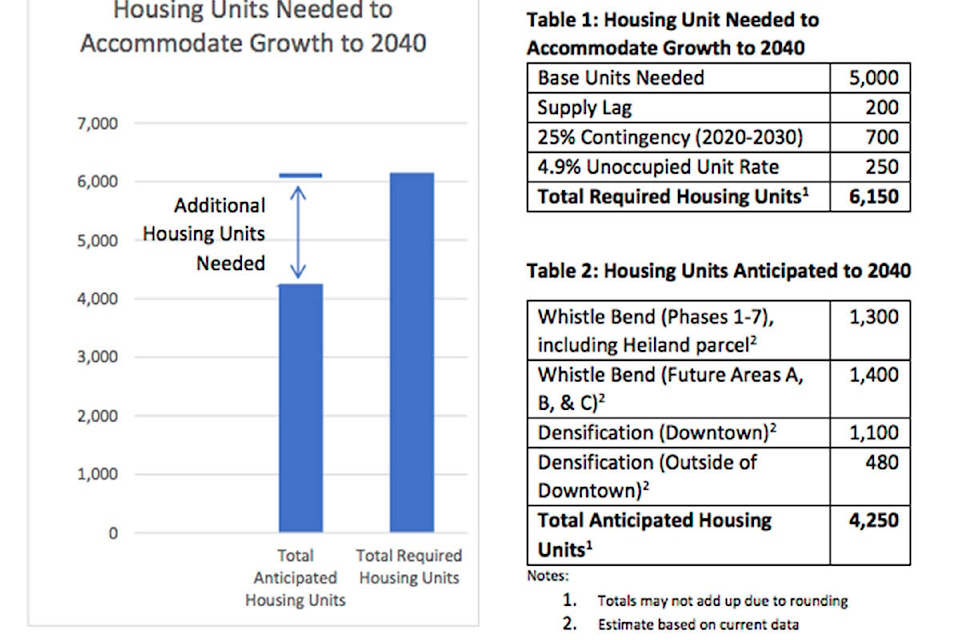The City of Whitehorse has released a study recommending residential growth in the city be accommodated through densification to existing neighbourhoods.
At the same time, it also recommends designating an area south of Copper Ridge to explore future residential planning beyond densifying current neighbourhoods.
The study — Accommodating Future Residential Demand In Whitehorse — was released as part of a Dec. 21 update toward a new Official Community Plan (OCP), which serves as a guiding document to city planning.
Earlier this year, the city released a What We Heard document on the public input into the OCP, which will set the vision for the city to 2040.
In it’s Dec. 21 update, the city said it is now moving towards creating the plan and had completed the study on future residential demand to incorporate into the plan.
The 26-page document, prepared by the city’s planning and sustainability department, explores different scenarios for population growth to 2040, identifying the number of housing units that will be needed in each one.
Based on Yukon Bureau of Statistics projections, a low-growth scenario would place the city’s 2040 population at 35,000 with 2,500 units needed, while the middle projection would see the population increase to 40,700 with 5,000 units needed.
A high-growth scenario places the 2040 population at 45,400 with a need for 7,000 units.
It’s noted the proposed number of units to be built doesn’t account for the current supply lag, contingencies or vacancies which would take the middle option up to 6,150 units, or about 300 homes every year to 2040.
“Some of these new units can certainly be built in existing neighbourhoods,” the study reads. “A preliminary estimate shows that Whistle Bend, when complete, could accommodate 1,300 more dwellings in addition to what exists in that neighbourhood today.”
And that doesn’t include the Whistle Bend expansion areas that may accommodate a further 1,400 housing units.
“Other neighbourhoods have not yet been fully developed in the sense that their existing zoning allows for a greater number of dwellings or units than has been taken advantage of by property owners at this time,” the study continues, going on to state densification through development of secondary suites or redeveloping older properties could also impact the number of units that would need to be developed.
Public input on the OCP highlighted strong support for greater densification, particularly downtown.
While development of new areas outside of Whistle Bend seemed less preferable, a survey done as part of the input showed new areas that could be considered. The area south of Copper Ridge saw the most public support at 49 per cent of respondents, followed by north of Long Lake at 29 per cent. Another 23 per cent wanted the focus to remain on densifying existing areas while 21 per cent said they’d prefer south of Porter Creek, known as Porter Creek D.
Other suggestions offered by the public included the tank farm area (owned and being developed by private interests), near Yukon University, First Nations settlement parcels and at the airport (with a suggestion to relocate the airport).
“There was a notable number of responses that opposed or had concerns with developing some of these areas (e.g. north of Long Lake and Porter Creek D).
The report also highlighted other city priorities and plans that would play a role in future development ranging from environmental stewardship to public safety, infrastructure renewal and more.
It also detailed the housing units built in the city each year between 2012 and 2020.
The biggest construction year came in 2020 when 348 new units were built, while the lowest year was in 2017 when 134 units were built.
Whistle Bend has seen the largest increase in new housing with multiple housing being majority of that, followed by single detached homes, then duplex/triplexes, living suites and garden suites.
Following Whistle Bend for neighbourhoods with new housing between 2012 and 2020 was Downtown, Porter Creek, Crestview, Takhini, Ingram and Riverdale in addition to other areas.
In looking at options to build within current city neighbourhoods, the city highlighted the possibility for 250 to 750 units to be built on city land within existing neighbourhoods; 200 to 850 units to be built in existing neighbourhoods should the zoning bylaw be amended to increase allowable density; 750 to 1,500 new units on potential First Nations settlement land; 1,200 to 1,400 units at the Tank Farm site; and 150 to 350 units at the 5th Avenue and Rogers Street site that the Yukon government has indicated interest in developing Downtown.
In total that creates potential for between 2,550 and 4,850 housing units in existing areas.
Expanding residential development to the area south of Copper Ridge could create potential for 7,140 units.
It’s noted that densifying in the city’s existing neighbourhoods meets a number of city considerations such as environmental stewardship, efficient use of infrastructure, housing choice and availability, and the support for densification over sprawl.
Meanwhile, the possibility of expanding south of Copper Ridge met only one such consideration, that being housing availability.
From the study, it’s recommended the OCP be drafted to support moving towards greater density in established neighbourhoods, while also designating south of Copper Ridge as an area for future residential planning.
The city would also continue to monitor the Yukon Bureau of Statistics’ population projections each year.
“In five years (or earlier, if population growth in Whitehorse exceeds YBS’ Preferred Projections), this direction should be reviewed along with updated population projections to determine whether initial planning for a new neighbourhood south of Copper Ridge should begin,” the study reads.
As the city moves forward with drafting the OCP in the New Year, officials said there will be opportunities to comment on the draft before it is finalized and brought to Whitehorse city council for adoption.
Contact Stephanie Waddell at stephanie.waddell@yukon-news.com
